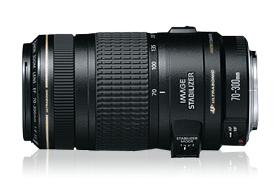1. Introduced in March 2011, the Canon EF 70–300mm f/4–5.6 L USM Telephoto Zoom Lens is an excellent choice for serious photographers and pros, whose interests are wildlife and sports, for example. To capture the best quality images of these and similar subjects, they need a lens with such outstanding optical quality and performance.
Read real customer reviews of the Canon EF 70-3000mm f/4-5.6 L USM Telephoto Zoom Lens here.

2. The lens’ “EF” designation refers to its “electronic focus” capability, controlled by the Ultra-Sonic Motor (USM) inside the lens, which makes for a very quiet, virtually silent, auto-focus (AF).
3. The Canon EF 70–300mm includes Canon’s Image Stabilization (IS) system, which Canon claims to be as many as 4 stops faster than the same size lens without IS. An additional feature of the IS system in this lens is that IS will remain activated when the camera is attached to a stiff tripod.
4. Another distinctive feature of the Canon 70–300mm, which is quickly evident, is that it is thick, short and white. Its diameter is 3.5" (89mm) and length 5.6" (143mm). The lens weighs 37 oz. (1,050g). This improves ergonomics and makes it easy to focus manually.
5. For many photographers, the exceptional lens construction of the Canon 70–300mm makes it worth the price. The zoom ring turns with great precision and trueness, so you can select focal lengths accurately and with very little motion or force of a finger. This is because of its all-metal cams, which are only found on better lens, plastic being the common material.
6. Study the lens rings carefully because zoom is the front ring and focus is the middle ring. You’ll also find a zoom lock at 70mm. The front of the lens extends as you zoom to 300mm. None of the external parts of the lens moves during auto-focus. There is an infrared focus index for 200, 100 and 70mm.
7. The Canon 70–300mm accepts 67mm filters and the all-metal filter thread does not rotate, but does move in and out with zooming.
8. The optics on the Canon EF 70–300mm f/4–5.6 include 19 multicoated glass elements in 14 groups. Two of these elements are of ultra-low dispersion (UD) glass. Canon has also added a fluorine front coating, which the company claims to be more smudge resistant than previous coatings.
9. The EF 70–300mm lens has an angle of view of 34º–8.25º (on 35mm and full-frame cameras).
10.Closest focus of the 70–300mm f/4–5.6 is 3.9 feet (1.2m).
11.To achieve more shooting balance, many photographers use the optional Canon Tripod Mount C (W II) to attach the lens directly to a tripod or monopod.
12.This new Canon lens doesn’t make your older Canon camera models obsolete. Attach it to any Canon DSLR and Canon auto-focus film camera from as far back as 1987.
13.Canon has cleverly satisfied both hobbyists and advanced and professional photographers who need a lens with a 70–300mm telephoto focal length. At approximately $1,600, the serious amateur and pro will want the Canon EF 70–300mm f/4–5.6 L USM lens’ outstanding optics, superior mechanics, fast auto-focus and friendly ergonomics. While hobbyists can choose the EF 70–300mm f/4–5.6 IS USM for approximately $550. It is constructed with many plastic parts, but has many of the same features and capabilities of the higher-priced EF 70–300mm f/4–5.6 L USM.
Your feedback is important to thousands of PhotographyTalk.com fans and us. If this article is helpful, then please click the Like and Re-Tweet buttons at the top left of this article.
This blog post about "Canon EF 70–300mm f/4-5.6 Telephoto Zoom Lens" was first published on our website here https://www.photographytalk.com/photography-equipment-reviews/1794-15-major-attractions-of-the-canon-ef-70300mm-f4-56-telephoto-zoom-lens